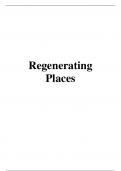Samenvatting
Summary Pearson Edexcel AS Level Geography - Unit 2 Topic 4A: Regenerating Places (Case Study-Based Theory)
- Vak
- Instelling
Detailed and comprehensive notes for unit 2 topic 4A (regenerating places) for edexcel AS level geography. The London Dockland’s regeneration has been used as the primary case study for a successful regeneration scheme, whereas the regeneration of Boscombe has been used as a case study of less su...
[Meer zien]













